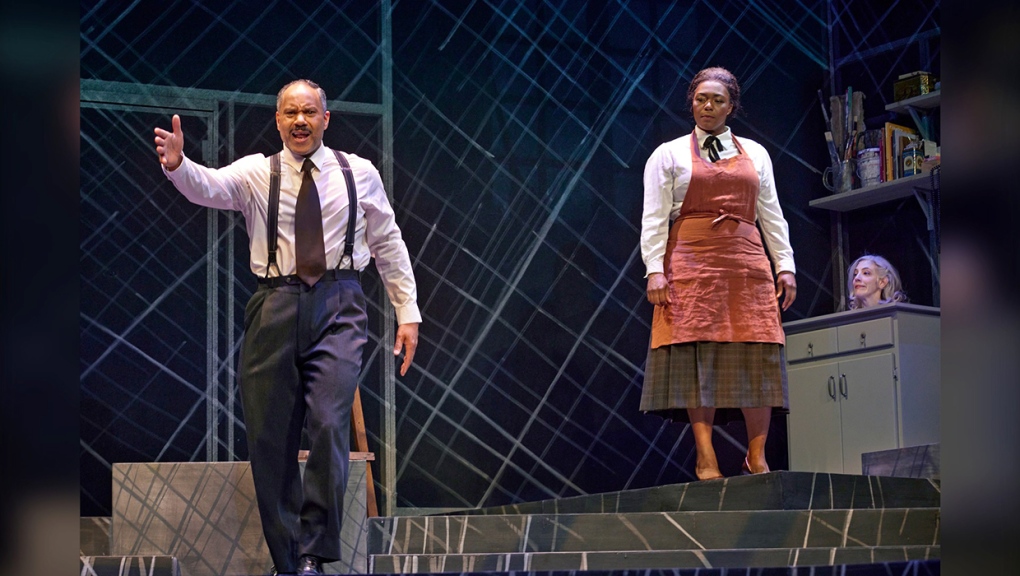Sculptor Selma Burke comes to imaginative, exuberant life in Calgary world premiere of new drama
Who gets to be statues?
That’s one of the questions asked in Selma Burke, an imaginative, exuberant new drama from a pair of Calgary playwrights, Caroline Russell-King and Maria Crooks in a world premiere presentation co-produced by Theatre Calgary and Alberta Theatre Projects.
Burke was a Black American sculptor born in 1900 who came of age in the Harlem Renaissance, where she was married to poet Claude McKay.
She managed to build a thriving career that included sculpting celebrities such as Duke Ellington, Martin Luther King Jr. and Booker T. Washington, along with ordinary American folks and a few wealthy white patrons as well.
Her growing prominence landed her a gig sketching the American president Franklin Delano Roosevelt, creating drawings that became the source for the image of Roosevelt on the American dime.
However, Burke was never acknowledged to have created that image, and for a long time, was lost to history — much like a lot of Black women who didn’t comfortably fit the narrative of what looked like a western civilization success story in the segregated United States of the 1930s, 40s, 50s and 60s.
 (l to r) Christopher Clare, Norma Lewis, Heather Pattengale in Selma Burke, a world premiere co-presentation by Theatre Calgary and Alberta Theatre Projects. Photo: Trudie Lee.
(l to r) Christopher Clare, Norma Lewis, Heather Pattengale in Selma Burke, a world premiere co-presentation by Theatre Calgary and Alberta Theatre Projects. Photo: Trudie Lee.
ROOTED IN PLACE AND TIME
Calgary actor Norma Lewis, who grew up in Edson, Alberta, and Calgary gives Burke a voice and a presence that immediately feels rooted in a place and time.
Lewis has a deep, booming voice that commands attention, and as young Selma, she’s mischievous and determined to pursue a career as an artist, however unlikely that seems to be possible for someone like her at that moment in U.S. history.
When Selma discovers that Henri Matisse, the great French sculptor, takes on the occasional student, but only the very gifted ones, Selma doesn’t miss a beat.
“He’ll take me,” she says, and before you can say, “Comment allez vous?” she’s in Matisse’s Paris studio, learning to find her signature style.
INTERNAL JOURNEY
The challenge with exploring an artist’s journey is that a lot of it is all about what goes on inside you and that can present a dramatic challenge when it comes to communicating that to an audience.
Russell-King and Crooks solve it in a delightfully theatrical way: the sculptures come to life and interact with Selma as she creates them.
The sculptures are embodied by Christopher Hunt, Heather Pattengale, and Christopher Clare, who alternate playing inanimate objects with playing 17 living characters, including FDR, J. Edgar Hoover, MLK, a new mom of a stillborn child, Elanor Roosevelt, a turkey, Selma’s second husband (Clare) and Selma’s third husband (Hunt).
Hunt (no relation) does a masterful job, jumping from FDR to J Edgar Hoover and he nails it on a montage of the greatest living artists of the early 20th century, who all, not coincidentally, are white guys – from Rodin to Pablo Picasso to Manet, Monet, Modigliani and all the rest, suggesting that Selma might run into some systematic resistance on her way to achieving artistic glory.
Clare’s Claude McKay is a complicated, flawed, alcoholic poet who can’t quite abide Selma’s strength or determination, and he pivots effortlessly to transforming into Duke Ellington and later MLK.
Pattengale is tremendous, whether playing a sculpture or a heartbroken new mother holding her stillborn baby.
ECONOMY AND ENERGY
It’s all directed with economy and energy by Delicia Turner Sonnenberg, who finds the humour in Selma’s journey and finds a way to turbo-charge a script that’s more episodic than plotted out in a narrative throughline.
But that’s what makes watching Selma Burke unfold, Forrest Gump-like, so much fun as it traces the creative life of a remarkable woman: Selma discovered along the way that no matter who she sculpted, some people weren’t going to be pleased.
In her own charming, relentless and positive way, she pushed back against the naysayers for the right to be able to continue to shape wood, clay and bronze into artworks that defined the historical moment for her — much like Russell-King and Crooks have done by digging into history and sharing Burke’s story.
For those asking, why an American sculptor? Russell-King also wrote an excellent drama about the Famous Five called High and Splendid Braveries, that explored the story of Nellie McClung and Alberta suffragette movement in the early 20th century, which shares something in common with Selma Burke – besides the fact that the Famous Five became a pretty cool sculpture in Olympic Plaza.
“I love writing about the stories of powerful, unsung women,” Russell-King said.
Russell-King and Maria Crooks have created a Selma Burke that is an inspiring, imaginative exploration of an extraordinary woman’s very 20th century life.
View original article here Source









